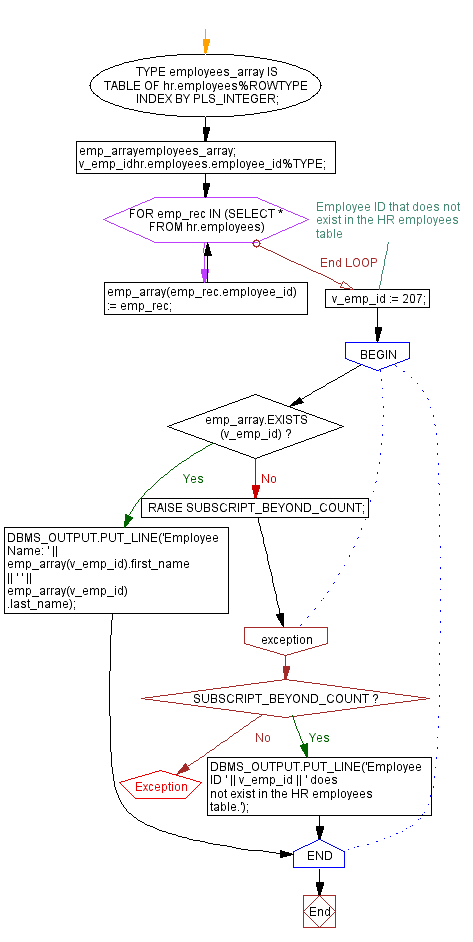Handling SUBSCRIPT_BEYOND_COUNT exception in PL/SQL
PL/SQL Exception Handling: Exercise-13 with Solution
Handle the SUBSCRIPT_BEYOND_COUNT exception when accessing an array element beyond its declared size.
Sample Solution:
Table: employees
employee_id integer first_name varchar(25) last_name varchar(25) email archar(25) phone_number varchar(15) hire_date date job_id varchar(25) salary integer commission_pct decimal(5,2) manager_id integer department_id integer
PL/SQL Code:
DECLARE
TYPE employees_array IS TABLE OF hr.employees%ROWTYPE INDEX BY PLS_INTEGER;
emp_arrayemployees_array;
v_emp_idhr.employees.employee_id%TYPE;
BEGIN
FOR emp_rec IN (SELECT * FROM hr.employees)
LOOP
emp_array(emp_rec.employee_id) := emp_rec;
END LOOP;
v_emp_id := 207; -- Employee ID that does not exist in the HR employees table
BEGIN
IF emp_array.EXISTS(v_emp_id) THEN
DBMS_OUTPUT.PUT_LINE('Employee Name: ' || emp_array(v_emp_id).first_name || ' ' || emp_array(v_emp_id).last_name);
ELSE
RAISE SUBSCRIPT_BEYOND_COUNT;
END IF;
EXCEPTION
WHEN SUBSCRIPT_BEYOND_COUNT THEN
DBMS_OUTPUT.PUT_LINE('Employee ID ' || v_emp_id || ' does not exist in the HR employees table.');
END;
END;
/
Sample Output:
Employee ID 207 does not exist in the HR employees table.
Explanation:
The said code in Oracle's PL/SQL that demonstrates how to handle the SUBSCRIPT_BEYOND_COUNT exception when accessing an index beyond the defined count in a PL/SQL associative array.
An array variable employees_array of type employees ROWTYPE indexed by PLS_INTEGER is declared. It then creates an instance emp_array of employees_array.
Then the code retrieves all records from the employees table and each record is assigned to the corresponding index in emp_array using the employee's ID as the index key.
After populating the emp_array, the code sets v_emp_id to a specific employee ID 207 that does not exist in the employees table.
Then a nested BEGIN-END block handles the potential exceptions. It checks whether v_emp_id exists in emp_array or not, If it exists, it retrieves the employee's first name and last name from emp_array and displays them using the DBMS_OUTPUT.PUT_LINE procedure.
If the employee ID does not exist in emp_array, it raises the SUBSCRIPT_BEYOND_COUNT exception and a corresponding error message is displayed using DBMS_OUTPUT.PUT_LINE.
Flowchart:

Go to:
PREV : Handling INVALID_TRANSACTION exception in PL/SQL with Example Code.
NEXT : Handling ROWTYPE_MISMATCH exception in PL/SQL.
Have another way to solve this solution? Contribute your code (and comments) through Disqus.
What is the difficulty level of this exercise?
